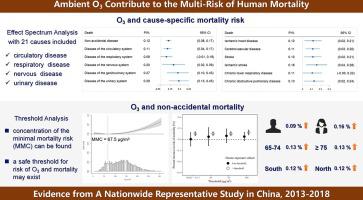Environment International ( IF 11.8 ) Pub Date : 2022-11-28 , DOI: 10.1016/j.envint.2022.107666 Chen Chen 1 , Tiantian Li 1 , Qinghua Sun 1 , Wanying Shi 1 , Mike Z He 2 , Jiaonan Wang 1 , Jing Liu 1 , Mengxue Zhang 1 , Qizheng Jiang 1 , Menghan Wang 1 , Xiaoming Shi 1

|
Background
Ambient ozone pollution is steadily increasing and becoming a major environmental risk factor contributing to the global disease burden. Although the association between short-term ozone exposure and mortality has been widely studied, results are mostly reported on deaths from non-accidental or total cardiopulmonary disease rather than a spectrum of causes. In particular, a knowledge gap still exists for the potential thresholds in mortality risks.
Methods
This nationwide time-series study in China included 323 counties totaling 230,266,168 residents. Daily maximum 8-hour average was calculated as the ozone exposure metric. A two-stage statistical approach was adopted to assess ozone effects on 21 cause-specific deaths for 2013–2018. The subset approach and threshold approach were utilized to explore potential thresholds, and stratification analysis was used to evaluate population susceptibility.
Results
On average, the annual mean ozone concentration was 93.4 μg/m3 across 323 counties. A 10-μg/m3 increase in lag 0–1 day of ozone was associated with increases of 0.12 % in mortality risk from non-accidental disease, 0.11 % from circulatory disease, 0.09 % from respiratory disease, 0.29 % from urinary system disease, and 0.20 % from nervous system disease. There may be a “safe” threshold in the ozone-mortality association, which may be between 60 and 100 μg/m3, and vary by cause of death. Women and older adults (especially those over 75) are more affected by short-term ozone exposure. Populations in North China had a higher risk of ozone-related circulatory mortality, while populations in South China had a higher risk of ozone-related respiratory mortality.
Conclusions
National findings link short-term ozone exposure to premature death from circulatory, respiratory, neurological, and urinary diseases, and provide evidence for a potential “safe” threshold in the association of ozone and mortality. These findings have important implications for helping policymakers tighten the relevant air quality standards and developing early warning systems for public health protection in China.



























 京公网安备 11010802027423号
京公网安备 11010802027423号